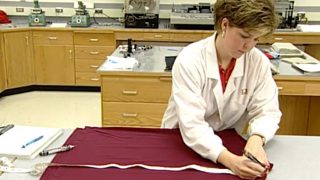Shrinkage Basics
What is Shrinkage?
Learn more about the basics of shrinkage:
Impact of Shrinkage
Shrinkage of textile and apparel products has always had a profound effect on design and production planning in all areas of textile and apparel manufacturing. In today’s competitive markets, where high quality is expected at a low price, apparel companies are demanding products with low levels of shrinkage from their suppliers.
Shrinkage Defined
“Dimensional change” means any change in dimensions of a fabric or garment, whether positive or negative. A positive change in dimensions is “growth,” and a negative change in dimensions is “shrinkage.” In garments, shrinkage characteristics relate not only to dimensional changes, but also to changes such as seam puckering and skew, changed relationships between the body cloth and trim components, and changes in fit. For the purposes of this course, shrinkage is defined as “a dimensional change in a fabric or garment caused by an application of a force, energy, or a change in the environment that either allows the goods to relax or forces the fabric to move in a given direction.”
Types of Shrinkage
Shrinkage and its causes can be broken down into two types: construction shrinkage and processing shrinkage. This means that shrinkage is affected both by the fabric’s construction parameters and by the forces applied during dyeing and finishing. Sewing and finishing processes during apparel manufacturing also can affect shrinkage. The shrinkage of a product is affected by both application and removal of stresses.
Physics of Shrinkage
Science tells us that the lowest energy state for a flexible rod is that of a straight rod. From a physics perspective, yarn is a flexible rod. The yarn is bent to form the loops in knits and the warp and filling yarns in weaving. The bending of the yarn and the amount of open space in the fabric determine the amount of shrinkage resulting from removal of stress on the yarns and reduction in the openness of the fabric.


